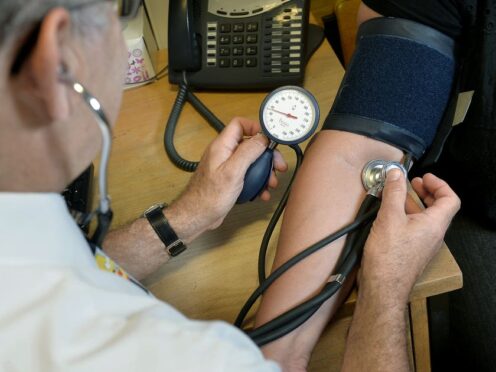Information collected as part of routine health checks could be used to estimate a patient’s risk of developing a number of diseases over 10 years, a study has suggested.
Researchers said this approach could ease pressure on primary care as well as enhancing the early detection of illnesses.
For the study, academics from the University of Oxford analysed data from 228,240 adults from the UK Biobank.
Using a set of predictors collected at standard primary care health checks, such as the NHS Health Check, the team produced a set of risk estimates with an accuracy of 70% or greater for a number of diseases simultaneously.
The illnesses included heart attack, heart failure, stroke, and atrial fibrillation – which causes and irregular and abnormally fast heartbeat – as well as dementia, chronic kidney disease, fatty liver disease, alcoholic liver disease, liver cirrhosis and liver failure.
The discriminative accuracy of risk scores produced were 73% for stroke, 82% for all-cause dementia, 79% for heart attacks, 78% for atrial fibrillation, 83% for heart failure, 77% for chronic kidney disease, 77% for fatty liver disease, 86% for alcoholic liver disease, 76% for liver cirrhosis and 75% for liver failure.
The NHS Health Check is offered to people aged 40 to 74 without certain pre-existing conditions.
Clinicians will usually take a patient’s blood pressure, height and weight, as well as asking a number of questions about family history and lifestyle, to give them an indication of their heart health and how at risk they are of developing heart disease, diabetes, kidney disease and stroke.
Researchers suggested their approach would allow patients to receive risk scores for more diseases at their check-up.
Earlier access to this information would allow for earlier intervention and more targeted use of resources, they said.
Lead author Celeste McCracken, of the University of Oxford’s Radcliffe Department of Medicine, added: “This data shows that it is possible to derive decent multiorgan risk estimates from information that can be collected remotely.
“We understand the NHS is resource-constrained, and this could have huge implications for people in hard-to-reach places.”
Researchers said the assessment could be carried out “without the need for specialist computing or invasive biomarkers”.
They added: “Such an approach could increase the utility of existing data and place multiorgan risk information at the fingertips of primary care providers, thus creating opportunities for longer term multimorbidity prevention.”
Ms McCracken added: “Our findings suggest that primary care providers could use a single set of easily collected information to simultaneously generate multiple disease risk scores.
“This could significantly streamline the process, potentially improving early disease detection and prevention efforts.”
However, the team said additional work is needed to determine if the findings – published in the BMJ Evidence-based Medicine – would hold in a larger cohort outside of the UK Biobank.
The study was supported by the National Institute for Health and Care Research (NIHR) Oxford Biomedical Research Centre (BRC).
